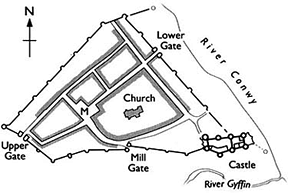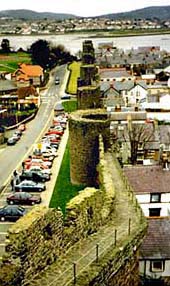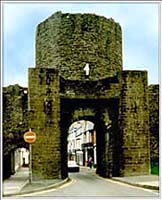 Fifty
miles or so west of Chester along the North Welsh coast you will find the beautiful
small market town and harbour of Conwy. Fifty
miles or so west of Chester along the North Welsh coast you will find the beautiful
small market town and harbour of Conwy.
After his conquest of Wales in 1283, King Edward I set out to
hold down the country with a series of magnificent castles of which Conwy, guarding
the crossing of the river Conway, was one of the largest. Not only was there
a castle, but also a fortified town, whose the circuit of walls still survive
in their entirety.
There had been people living here long before that, of course. The pearl fishery
in the Conwy river was famous before the coming of the Legions- indeed the Roman
general Suetonius declared its acquisition to be one of his main motives for
subjugating the country around.
A shield of great value and exquisite workmanship, dedicated by Julius Caesar
to Venus Genetrix, and placed by him in her temple in Rome, was encrusted with
British pearls.
Conwy Castle, seen behind the young American visitors
in our photograph, is a masterpiece of medieval military architecture and is
associated with one of the greatest circuits of town walls to be found anywhere
in Europe- more than three quarters of a mile in length, with 22 great towers
and three original gateways.
Old illustrations show that Chester's fortified medieval gates, which were removed
in the 18th and early 19th centuries, must once have looked very like the ones which
survive here in Conwy. Most of Chester's ancient castle,
too, was swept away during the 19th century to be replaced with Thomas Harrison's Greek Revival buildings.
Conwy's walls, castle and town were, remarkably, constructed in only seven years- between
1283 and 1289- and played an important part in King Edward I's plan of surrounding
Wales in "an iron ring of castles" to subdue the rebellious population.  The
highly defensible wall Edward built around the town was intended to protect
the English colony planted at Conwy as the native population were justifiably-
and violently- opposed to the forced occupation of their homeland. The
highly defensible wall Edward built around the town was intended to protect
the English colony planted at Conwy as the native population were justifiably-
and violently- opposed to the forced occupation of their homeland.
The design and direction of the building work was undertaken by James of St. George, the greatest military architect and master mason
of his time, who was summoned from mainland Europe to implement Edward's ambitious
plans. He was born around 1230 and worked on a number of great European castles
before starting on his massive undertaking for Edward.
The beautiful Beaumaris
Castle, on the island of Anglesey was his final design in Wales and with
this he perfected his concept of the 'concentric castle'.
A town wall exists, linked to the great castle at Caernarfon, but it
is far from complete and gets lost in the modern town. By contrast, Conwy's
well-preserved wall helps the town maintain a medieval character lost by most
other Welsh castle-towns over the years.
Today, Conwy is approached from Chester and the east via the A55 road along
the North Wales coast. Approaching the town, the castle seems to suddenly rise
out of the hills. Thomas Telford's majestic old suspension bridge, connecting
the castle with the main peninsula, and depicted in many representations of
the castle over the years, has been out of use since the 1950s. A new bridge
runs parallel with the old and is the only way to enter Conwy from the east.
The magnificent castle dominates the entrance to the town, immediately conveying its sense
of strength and compactness to the observer. The eight great towers and connecting
walls are all intact, forming a rectangle as opposed to the concentric layouts
of Edward's other castles in Wales.
Almost all of the castle is accessible and well preserved. Journeying to the
top of any of the towers offers the visitor spectacular views of the town, surrounding
coastline and countryside. Sailboats and other pleasure craft dot the picturesque
harbour and quay next to the castle, while flocks of sheep may be observed everywhere on
the nearby hills.
When exploring the waterfront, pay a visit to what is allegedly
"the smallest house in Britain" or sit outside the Liverpool Arms pub, taking in the spectacle with a pint
of their excellent beer
.
Conwy Castle dominates the skyline from literally all points along
the town wall. The spur wall projecting 60 yards from the end of the quay offers
some of the best views, especially at night, when the floodlit castle is a memorable
spectacle.
Joseph Hemingway, writing in the1830s about the vanished medieval and
Roman gates of Chester, gives
the following description:
"From each side of the gates projected a propugnaculum (a wonderful word)
or bastion in order to annoy the enemy who attempted to enter; between
them, in the very entrance, was the cataract or portcullis ready
to be dropped in case they forced the gates; so that part of them might be caught
within the walls, and slaughtered, and the rest excluded. Should it happen that
the gates were set on fire, there were holes above, in order to pour down water
and extinguish the flames.
The walls were in many parts guarded by towers, the remains of which are still
visible (far better here at Conwy than at Chester) placed so as not to be beyond
bow-shot of one another, in order that the archers might reach the enemy who
attempted to gain the intervals. They were also mostly of a round form, as was
early recommended by Roman architects such as Vertruvius in order more
effectually to resist the force of battering rams".
Vertruvius' works upon military defences had been the standard reference for
hundreds of years and would have been very familiar to Conwy's builder, James
of St. George.
All this is easy to comprehend as one surveys Conwy's formidable towers and
gates, such as the Upper Gate, shown here.
Conwy seems like a town that time has simply chosen to pass by.
Despite the traffic and modern goods in the shops, it still looks very similar
to the town Edward envisioned some 700 years ago.
Actually, the traffic situation is much improved since a by-passing tunnel
was been built a few years ago. Formerly, the A55 main coastal route passed straight through
the town centre and was for years a notorious bottleneck.
Today, the ancient town walls, castle and simple streets thankfully continue
to offer very little to remind the visitor of the modern world.
In High
Street, you will find one of the most impressive and best-preserved Elizabethan
town houses anywhere in Britain, Plas Mawr, which was built between the years 1575
and 1585 and is open to the public.
One of the bells from the great Abbey of St. Werburgh,
(Chester Cathedral) now hangs in Conwy's little church, having been sold
by the Abbot and removed here during the frantic period of 'asset-stripping'
immediately prior to the dissolution of the monastery by the agents of Henry
VIII in 1540.
All in all, Conwy remains something of a paradox. Originally a
symbol of the English domination of Wales, in time the Welsh managed to reclaim
their town, replacing English oppression with its own medieval character. At
Conwy we get the feeling of being transported back to ancient Wales.
Despite this, it is an easy journey from Chester and is a place not to be missed
by any visitor to Britain. |
 Fifty
miles or so west of Chester along the North Welsh coast you will find the beautiful
small market town and harbour of Conwy.
Fifty
miles or so west of Chester along the North Welsh coast you will find the beautiful
small market town and harbour of Conwy. The
highly defensible wall Edward built around the town was intended to protect
the English colony planted at Conwy as the native population were justifiably-
and violently- opposed to the forced occupation of their homeland.
The
highly defensible wall Edward built around the town was intended to protect
the English colony planted at Conwy as the native population were justifiably-
and violently- opposed to the forced occupation of their homeland.

